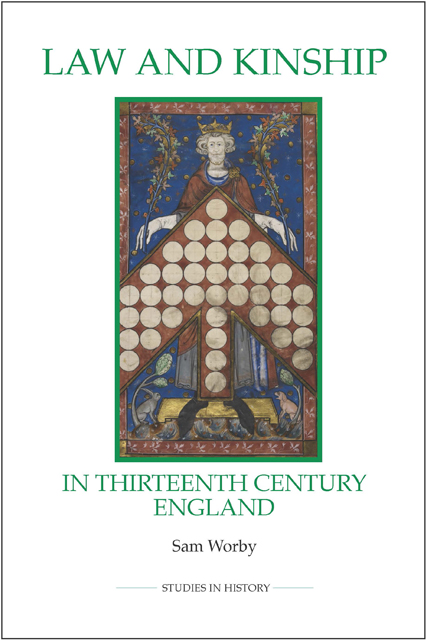Book contents
- Frontmatter
- Contents
- List of illustrations
- List of tables
- Acknowledgements
- Abbreviations
- Introduction
- 1 Canon law kinship structures
- 2 Common law kinship structures
- 3 The dominance of canon law kinship ideas
- 4 Kinship laws in practice
- 5 Trends underlying legal kinship structures
- Conclusion
- Appendices
- Bibliography
- Index
4 - Common law adaptations of canon law treatises: Triplex est
Published online by Cambridge University Press: 01 March 2023
- Frontmatter
- Contents
- List of illustrations
- List of tables
- Acknowledgements
- Abbreviations
- Introduction
- 1 Canon law kinship structures
- 2 Common law kinship structures
- 3 The dominance of canon law kinship ideas
- 4 Kinship laws in practice
- 5 Trends underlying legal kinship structures
- Conclusion
- Appendices
- Bibliography
- Index
Summary
This is a transcription of Triplex est , an adaptation of the section ‘De cognatione carnali’ from Raymón de Penyafort's Summa de matrimonio , made by common lawyers probably around the end of the thirteenth century. This adapted treatise is paired with Quibus modisin BL, MS Harley 653, fos 41r–v (H)and Worcester Cathedral Library, MS F 87, fo. 29r (W) . The transcription is based on the two manuscripts, compared with the 1603 edition of Raymón's Summa(Sm) : St Raymundus de Peniafort, Summa de poenitentia et matrimonio [a facsimilie of the Rome edition of 1603],Farnborough 1967, 533–6, with one small section compared with Bracton , ii. 200 (Br).
1 ‘De triplici cognatione Raymundi’
2 Item triplex est cognatio, scilicet carnalis, spiritualis, et legalis; et quia carnalis, cognatio ‘consanguinitas’ appellatur, alias duas species cognationis precedit naturaliter, ideo primo videamus de ea que consanguinitas appellatur.
3 Quamvis sint multa et varia de consanguinitate scripta a doctoribus et maioribus nostris, super expositione tam arboris quam diversorum canonum, qui superficialiter videntur esse contrarii, tamen de multis pauca utilia, que ad presentem doctrinam faciunt, hic sunt compilata.
4 Videndum ergo quid sit consanguinitas, et unde dicatur, et que linea consanguinitatis, et quot sunt linee, et quid sit gradus, et qualiter gradus computentur, et usque ad quem gradum matrimonium prohibeatur.
5 Est enim consanguinitas vinculum personarum ab eodem stipite descendentium carnali compagine contractum.
6 Stipitem dico illam primam personam a qua alii duxerunt originem, sicut Adam fuit stipes Caym et Abel et filiorum qui ab eis processerunt.
7 Dicitur enim consanguinitas a con et sanguine, quasi communem sanguinem habentes, vel de uno sanguine procedentes.
8 Linea est collectio personarum ordinata consanguinitate iunctarum, ab eodem stipite descendentium, diversos gradus continens.
9 Linee sunt tres: ascendentium, transversalium sive collateralium, sicut triplex est propinquorum diversitas seu etiam consanguineorum.
10 Prima est ascendentium, a quibus originem traximus, sicut pater, mater, avus, avia, proavus, proavia, pronepos, proneptis, abnepos, abneptis.
11 Alia est transversalium, sive collateralium, ut ex transverso seu a latere venientium, a quibus non duximus originem nec ipsi a nobis, ut frater et soror, filii enim fratrum qui dicuntur ‘fratres patrueles’; vel duarum sororum filii qui dicuntur ‘consobrini’, et eorundem filii et nepotes.
- Type
- Chapter
- Information
- Law and Kinship in Thirteenth-Century England , pp. 175 - 182Publisher: Boydell & BrewerPrint publication year: 2010

